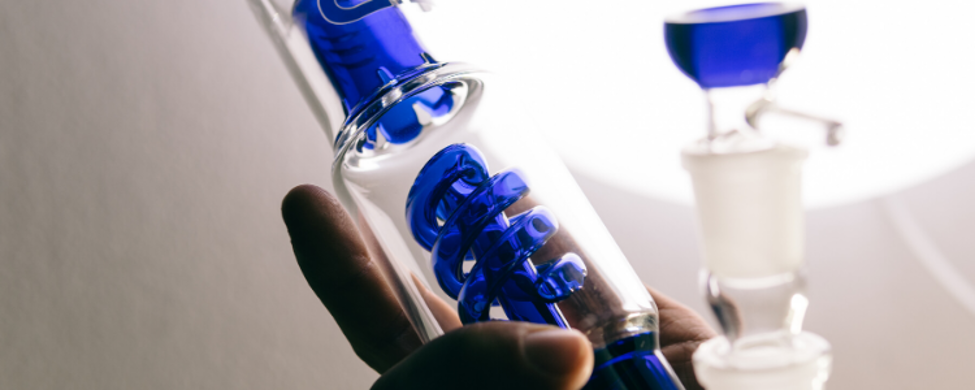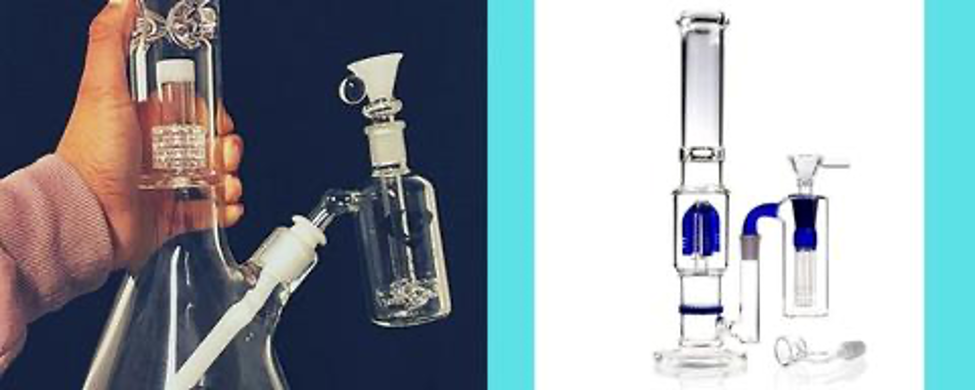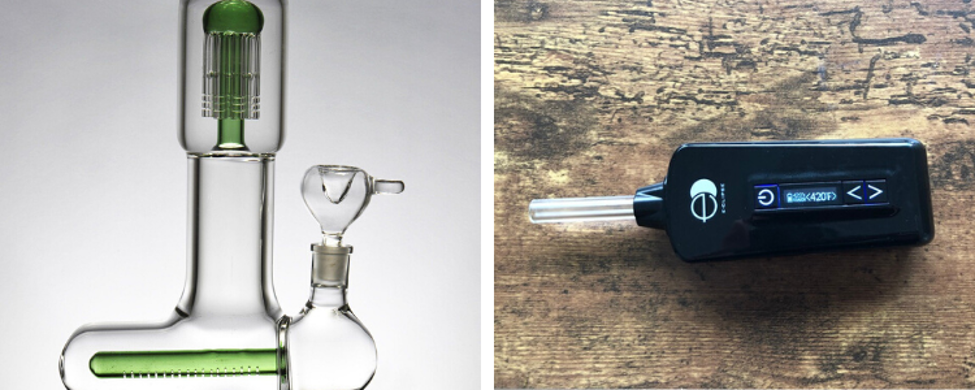A percolator bong is a bong with a speciality downstem. Instead of having a simple opening that releases smoke into the reservoir of water, the downstem will have several different holes for the smoke to filter through. The multiple exit points force the smoke to percolate through the water, resulting in a cooler, smoother tasting hit being produced from the percolator bong than you would otherwise get from a more standard design.
Percolator bongs come in all different kinds of designs and are made out of many different kinds of materials. You can find percolator bongs in glass, silicone, plastic, as well as a combination of different materials. Each kind of material offers its own benefits to the smoking process, which we will list below.

Glass Percolator Bongs
Glass percolator bongs continue the tradition of the classic bong design. Glass is a nonporous material, meaning that it will not interfere with the flavor of what is being smoked. For those that consider themselves connoisseurs of dry herb flavor, glass pipes have long been the standard they look to. However, glass is not without its drawbacks. Namely, glass percolator bongs are expensive and fragile. Percolator bongs are even more so, as their downstems can have small, intricate glass parts that can easily shatter if not properly cared for.
![]()
Silicone Percolator Bongs
Silicone is an up-and-coming material that has been increasingly used in bongs and pipes. Silicone is inexpensive and extremely durable. If you find one you like, even novice owners will be able to care for them for years to come. They are also very easy to clean and are often able to be broken down into several parts, making getting stubborn residue cleaned even easier. However, you will not get quite as clean a flavor from silicone as you will from a glass percolator bong.
Plastic Percolator Bongs
Plastic has a lot of the same benefits as silicone. It is far more durable than glass and it is pretty easy to find plastic bongs that come in several pieces to make cleaning easier. However, unlike silicone, plastic can grow brittle and break over time, through a plastic percolator bong will be pretty inexpensive to replace. Plastic will also not give you quite the flavor glass will, and plastic can start to look pretty gnarly after extended use, even if you keep up with regular cleaning.
Bong Percolator Types
The different materials aside, percolator bongs come in all different kinds of designs. There are literally dozens of different types you can find, including custom designs that are one of a kind. However, there are some more common kinds of percolators that you will find in bongs, each having their own unique advantages of use. Take a look at the list below to learn more!
Honeycomb Percolators
Honeycomb percolators are disks with dozens of holes. They interact with the smoke after it is in the bong water. As the bubbles rise, they are forced through the tiny holes of the percolator, resulting in extra filtration.
Tree Percolators
A tree percolator is all about making bubbles. Are is drawn through a central tube where it forces water into one of several arms present (hence the “tree” in the name). The air is then forced through the slits in the arm, resulting in a lot of extra bubbling, improving the flavor of the hit drastically.
Inline Percolators
Inline percolators are a simple design, with the exit point of the smoke coming from a horizontal bar with a number of openings. This is in contrast to traditional downstems, which usually are at an angle for smoke release. It is a simple, inexpensive design that does a great job improving the flavor of your hit.
Showerhead Percolators
These are very similar to tree percolators, using the same mechanism to force water through a filter of holes. However, instead of having separate arms that diffuse the smoke, it instead uses a solid disk with several holes. This allows the smoke to diffuse more evenly for a smoother flavor. It also makes the percolator less prone to breaking or cracking.
Matrix Percolators
Imagine two or more showerhead percolators stacked on top of each other. That is a matrix percolator! They allow for slightly more diffusion than a showerhead, though many will say the actual difference in flavor is minimal. However, they look amazing when used, which has attracted many customers to them.
Turbine Percolators
Turbines are disc-style percolators that have a very similar look and feel to honeycombs. Like honeycombs, they are also easily stacked for multiplying percolating power. However, unlike honeycombs, turbines have just a few holes that are very large for the smoke to pass through. This means that the effect on flavor will not be as strong, but it guides the water into a cyclone-like action. Turbines are great if you are trying to avoid water splashing within the bong.
Fritted Disc Percolators
Fritted discs are one of, if not the, best design if you are trying to get the most percolation possible in your bong. They have hundreds of tiny holes that create so many more bubbles than any other design of percolators. Since they are a disc design, you can also stack them (like honeycomb and others) to enhance their effect. However, since they offer so many more holes and percolation than other models, it will be significantly more difficult to take a draw then when compared to other designs.
Spiral Percolators
Spiral percolators act as traditional downstems except they look like long, swirly silly straws! They have a great aesthetic, but they certainly are not without practical function. They will not percolate as much as other designs, but since the smoke has such a long path to travel, they will cool your hit significantly more than other downstems or percolators.
Double Percolator Bong
As the name implies, there are two separate percolators present in a double percolator bong. These can be stacked percolators (which is quite common to see with disc-types like honeycombs or fritted discs), or it can be two completely different percolators that work together. For example, you may have your smoke go through a fritted disk and then go through a tree percolator on its way up. The more percolation you have, the smoother and cooler your hit will be, though you do need to be wary of how much drag you are creating.
Honeycomb Percolator Bong
Honeycomb percolators have become quite a popular choice among smokers. A honeycomb percolator is just a disk with dozens of small holes. When the smoke enters the bong water and bubbles, those bubbles are forced through the small holes in the honeycomb, forcing more filtration. This interaction allows the smoke to be very smooth and cool. Honeycomb percolators can also easily be found in a double percolator style, as the disks are very easy to have stacked on top of each other.
Best Percolator Bongs
As you can see, there are all different kinds of percolator bongs to choose from, anywhere from percolators that replace the downstem, percolators that act as extra filters, or even some that work together to do both. However, the “best” percolator is going to come down to which one best fits your wants out of a smoking experience. For example, if flavor is a priority, you likely want a fritted-disc (and perhaps even a few stacked on each other). However, if you are trying to avoid drag and difficulty in taking hits, then this setup is going to end up really disappointing you. Decide specifically what you want in terms of function, flavor, and looks, and then find the percolator bong that best fits your vision!

Bong Diffuser
Bong diffusers are quite similar to percolators and are often used in conjunction with them, though there are some important differences to consider. Bong diffusers completely replace the downstem and will sit in the same place and in a similar position. However, instead of having just an open hole for the smoke to exit, a diffuser will have several small holes that force the smoke to diffuse into the water. You get a much cooler and smoother hit than you would with a traditional downstem.
It should be pretty easy to see why a diffuser and a percolator would be used together, too. They both have the same goal! It is not uncommon to have a diffuser that then has a disc-style percolator (like a honeycomb) on top of it to further filter the hit. However, as we said, diffusers are not percolators. They do not agitate the water like percolators typically do, and the diffusing or filtration process happens at different points in the smoking process.
Bong vs Percolator Bong
The difference between the traditional style of the bong and a bong with a percolator can be described as ease-of-use versus premium flavor. A standard bong is not going to filter and cool the hit like a percolator is going to be able to do. However, a standard bong is going to be much easier to take a draw on, since percolators create the drag, and they will be easier to clean and maintain. Traditional bongs are also less expensive and less prone to damage than their percolator counterparts.
Percolator bongs, on the other hand, do a much better job of producing a smooth, cool, and overall great tasting hit. However, they do require more effort to take a hit, and the small, fragile pieces of the percolator can prove difficult to clean. They can also be quite fragile (especially in designs like tree percolators) and if you happen to break a piece, you usually have to replace the entire bong. However, the flavor that they offer is second to none!
Dab Rig vs Percolator Bong
The main difference between a dab rig and a percolator bong is the difference between the bong bowl or the dab nail. The bong bowl is the part that holds the dry herb being smoked and can usually be packed quite heavily. A dab nail, on the other hand, serves a different purpose entirely. It is designed to smoke wax concentrates, so they are made out of heatable materials as well as the ability to gently place concentrates on the heating nail for smoking. Once the materials are smoked, though, there is no functional difference between the vapor path of a dab rig or percolator bong. In fact, if you have a dab nail that will fit, you can use a percolator bong to smoke wax concentrates. The percolating process will benefit the flavor just as it would with smoking dry herbs.

Percolator Bong vs Vape Pen
It is somewhat hard to compare these two because their functions are so widely different. A vape pen is small, battery-powered, and meant to be easily portable and used discreetly. Vape pens meant for dry herbs often use convection style heating, meaning that there is no smoke produced (just vapor from essentially baking the dry herbs.).
Percolator bongs, on the other hand, use combustion (or literally flames and burning) to produce smoke for inhaling. They also use water as a filtration method, and they have a size that makes using on the go not practical. Even traveling with a glass percolator bong can prove difficult because of how fragile they can be. Both a percolator bong and vape pen have their very specific pros and cons, each fitting into their specific functions quite nicely.
How to Clean a Percolator Bong
Percolator bongs will require regular cleaning to ensure that the small holes in your chosen percolator do not become clogged with residue. The following steps will help make sure that you always have the best smoking experience with your percolator bong.
- Remove the bong bowl as well as any other removable parts you can from the bong. If you have a silicone bong, you may have several pieces you can remove.
- Dump out the bong water.
- Prepare a soaking solution for your bong to rest in. You need to have a container deep enough to completely submerge the bong. You can use isopropyl alcohol for this method, as well as speciality cleaners like 420 Cleaner (which we recommend).
- Allow the bong to soak for at least 45 minutes. If you have noticeably stubborn residue, allow the bong to soak longer.
- If residue persists, fill the body of the bong with a saltwater solution and swish it around. Saltwater acts as a gentle scrubbing agent that can help remove more stubborn residue.
- Once cleaned to your preference, completely rinse the bong and all related pieces.
- Once thoroughly rinsed, allow the bong to completely air dry before using again.
